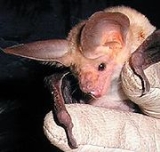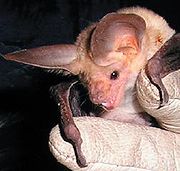
Pallid bat
Encyclopedia
The Pallid Bat is a species of bat
that ranges from western Canada
to central Mexico
. It is the sole species of its genus and is closely related to Van Gelder's Bat
(Bauerus dubiaquercus), which is sometimes included in Antrozous. Although it has in the past been placed in its own subfamily (Antrozoinae) or even family (Antrozoidae), it is now considered part of the subfamily Vespertilioninae
and the tribe Antrozoini
.
Pallid bats have larger eyes than most other species of bats in North America
and have pale, long, and wide ears; their fur is generally lightly colored. They have on average a total length of 92 to 135 mm (3.6 to 5.3 in).
Pallid Bats are insectivore
s that feed on arthropod
s such as cricket
s and scorpion
s, and are capable of consuming up to half their weight in arthropods every night. Although they normally catch their prey on the ground, they usually transport their prey to their night roost to eat it.
 The mating season ranges from October to February. The female bat gives birth to twins during early June; they weigh approximately 3 to 3.5 g (0.105821886315336 to 0.123458867367892 oz) at birth and in four or five weeks are capable of making short flights. They don't attain adult size until about eight weeks of age, and don't become sexually mature until after approximately two years.
The mating season ranges from October to February. The female bat gives birth to twins during early June; they weigh approximately 3 to 3.5 g (0.105821886315336 to 0.123458867367892 oz) at birth and in four or five weeks are capable of making short flights. They don't attain adult size until about eight weeks of age, and don't become sexually mature until after approximately two years.
Their large ears allow them to hear the footsteps of insects on the ground and they use their voices to make ultrasonic sounds that bounce back to their ears. The reflected sound waves let them sense flying insects and know the environment they are flying through.
Pallid bats are a unique type of bat because they are heterothermic, which means that, depending on the time of year, they can be either poikilotherm
ic or homoeothermic
. They have the ability to control their body temperature and equilibrate it with the environment during winter hibernation
and whenever they rest.
They primarily sleep in rock crevices and buildings. Pallid bats are skilled at climbing and crawling.
Bat
Bats are mammals of the order Chiroptera "hand" and pteron "wing") whose forelimbs form webbed wings, making them the only mammals naturally capable of true and sustained flight. By contrast, other mammals said to fly, such as flying squirrels, gliding possums, and colugos, glide rather than fly,...
that ranges from western Canada
Canada
Canada is a North American country consisting of ten provinces and three territories. Located in the northern part of the continent, it extends from the Atlantic Ocean in the east to the Pacific Ocean in the west, and northward into the Arctic Ocean...
to central Mexico
Mexico
The United Mexican States , commonly known as Mexico , is a federal constitutional republic in North America. It is bordered on the north by the United States; on the south and west by the Pacific Ocean; on the southeast by Guatemala, Belize, and the Caribbean Sea; and on the east by the Gulf of...
. It is the sole species of its genus and is closely related to Van Gelder's Bat
Van Gelder's Bat
Van Gelder's Bat is a species of vesper bat in the Vespertilionidae family.It is found in Belize, Costa Rica, Honduras, and Mexico. It is monotypic within its genus...
(Bauerus dubiaquercus), which is sometimes included in Antrozous. Although it has in the past been placed in its own subfamily (Antrozoinae) or even family (Antrozoidae), it is now considered part of the subfamily Vespertilioninae
Vespertilioninae
Vespertilioninae is a subfamily of Vesper Bats from the family Vespertilionidae.-Classification:Subfamily Vespertilioninae*Tribe Eptesicini**Genus Arielulus***Collared Pipistrelle, Arielulus aureocollaris...
and the tribe Antrozoini
Antrozoini
Antrozoini is a tribe of bats in the subfamily Vespertilioninae of the family Vespertilionidae. It includes at least the pallid bat , Van Gelder's bat , and the fossil Anzanycteris; some classifications also include the genera Rhogeessa and Baeodon.-Taxonomy:The pallid bat was first described in...
.
Pallid bats have larger eyes than most other species of bats in North America
North America
North America is a continent wholly within the Northern Hemisphere and almost wholly within the Western Hemisphere. It is also considered a northern subcontinent of the Americas...
and have pale, long, and wide ears; their fur is generally lightly colored. They have on average a total length of 92 to 135 mm (3.6 to 5.3 in).
Pallid Bats are insectivore
Insectivore
An insectivore is a type of carnivore with a diet that consists chiefly of insects and similar small creatures. An alternate term is entomophage, which also refers to the human practice of eating insects....
s that feed on arthropod
Arthropod
An arthropod is an invertebrate animal having an exoskeleton , a segmented body, and jointed appendages. Arthropods are members of the phylum Arthropoda , and include the insects, arachnids, crustaceans, and others...
s such as cricket
Cricket (insect)
Crickets, family Gryllidae , are insects somewhat related to grasshoppers, and more closely related to katydids or bush crickets . They have somewhat flattened bodies and long antennae. There are about 900 species of crickets...
s and scorpion
Scorpion
Scorpions are predatory arthropod animals of the order Scorpiones within the class Arachnida. They have eight legs and are easily recognized by the pair of grasping claws and the narrow, segmented tail, often carried in a characteristic forward curve over the back, ending with a venomous stinger...
s, and are capable of consuming up to half their weight in arthropods every night. Although they normally catch their prey on the ground, they usually transport their prey to their night roost to eat it.

Their large ears allow them to hear the footsteps of insects on the ground and they use their voices to make ultrasonic sounds that bounce back to their ears. The reflected sound waves let them sense flying insects and know the environment they are flying through.
Pallid bats are a unique type of bat because they are heterothermic, which means that, depending on the time of year, they can be either poikilotherm
Poikilotherm
A poikilotherm is an organism whose internal temperature varies considerably. It is the opposite of a homeotherm, an organism which maintains thermal homeostasis. Usually the variation is a consequence of variation in the ambient environmental temperature...
ic or homoeothermic
Warm-blooded
The term warm-blooded is a colloquial term to describe animal species which have a relatively higher blood temperature, and maintain thermal homeostasis primarily through internal metabolic processes...
. They have the ability to control their body temperature and equilibrate it with the environment during winter hibernation
Hibernation
Hibernation is a state of inactivity and metabolic depression in animals, characterized by lower body temperature, slower breathing, and lower metabolic rate. Hibernating animals conserve food, especially during winter when food supplies are limited, tapping energy reserves, body fat, at a slow rate...
and whenever they rest.
They primarily sleep in rock crevices and buildings. Pallid bats are skilled at climbing and crawling.

